#tomb of nefertari
Text
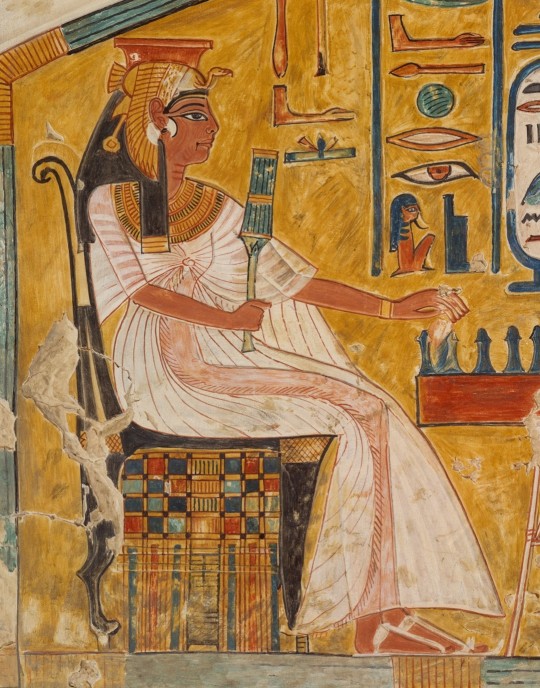
Queen Nefertari Playing Senet - Met Museum Collection
Note: This is a modern copy of an original
Inventory Number: 30.4.145
Original Dating: New Kingdom, Ramesside, Dynasty 19, ca. 1279–1213 B.C.
Location Information: Original from Egypt, Upper Egypt, Thebes, Valley of the Queens (Biban el-Malikat), Tomb of Nefertari (QV 66)
Description:
This facsimile copies of one of the paintings from Nefertari's tomb. In this vignette, the queen sits in front of a table playing a game of senet again an invisible opponent. This was a popular game in life, but when represented in a tomb, as here, it has symbolic meaning. The word senet means "passing" and the game was seen as a parallel to the journey into the afterlife and the obstacles one had to overcome on the way.
In the scene, Nefertari wears an elaborately pleated and fringed gown of sheer linen. She also wears a gold bracelet, a broad collar, and what are probably silver earrings. On her head is the vulture headdress of a queen. The facsimile was painted at the tomb in 1921-1922 by Nina deGaris Davies who was a member of the Graphic Section of the Museum's Egyptian Expedition.
#Queen Nefertari Playing Senet#new kingdom#ramesside#dynasty 19#upper egypt#thebes#valley of the queens#tomb of nefertari#met museum#30.4.145#womens clothing#NKRWC
1 note
·
View note
Text
Valley of the Queens
Home to 91 tombs of queens and princes, the Valley of the Queens offers an interesting contrast to the better known, and far more visited, Valley of the Kings. It was wonderful to arrive to basically have the valley to myself, in contrast with the 4,000 to 5,000 daily visitors to the Valley of the Kings.
Dating from a similar period to the Valley of the Kings the main the reason for visiting is…

View On WordPress
#Amunherkhepshef#Egypt#Khaemwaset#Luxor#Nefertari#photography#Tomb of Amunherkhepshef#Tomb of Khaemwaset#Tomb of Nefertari#Tomb of Tyti#travel#Tyti#Valley of the Queens
0 notes
Text

Horus guides Queen Nefertari into the Underworld.
Translations of the accompanying texts:
"Djed medu in Hor sa Ast" - WORDS SPOKEN BY HORUS, SON OF ISIS
"Hemt weret Nebet Tawy Nefertari ankhti maat-kheru kher Asir netcher aa" - THE GREAT QUEEN, LADY OF THE TWO LANDS, NEFERTARI, GRANTED LIFE, TRUE OF VOICE BEFORE OSIRIS, THE GREAT GOD
#Horus#Nefertari#Osiris#valley of the queens#Luxor#thebes#waset#Kemet#Kemetic#Kemeticism#Egypt#Egyptian#ancient Egypt#ancient Egyptian#egyptology#tomb
57 notes
·
View notes
Photo
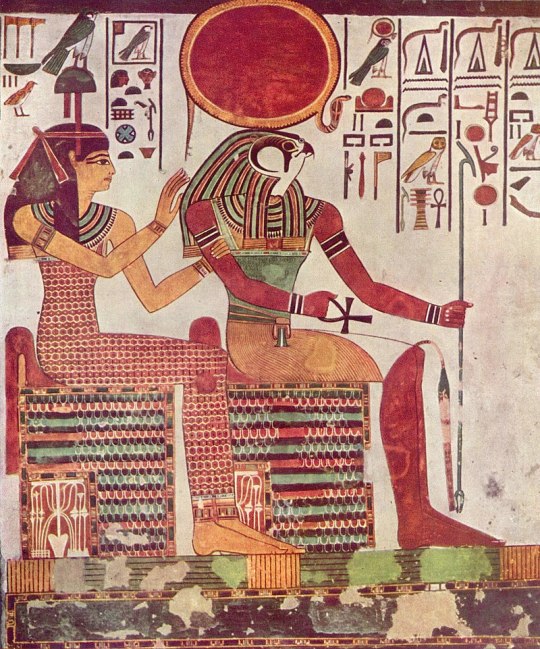
Imentet and Ra from the tomb of Nefertari, 13th century BC
#Imentet#Ra#Tomb#ancient egypt#nefertari#13th century#ancient monument#ancient#egypt#goddess#God#ancient Egyptian religion#Symbols and objects#Egyptian queen#Nefertari Meritmut
300 notes
·
View notes
Text

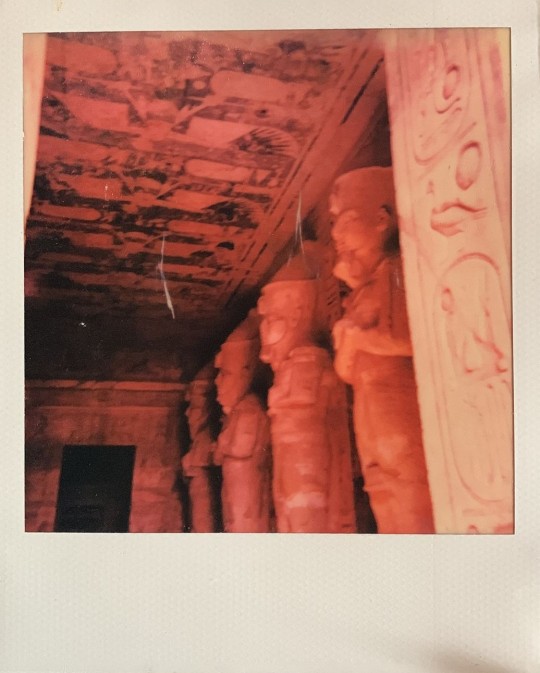
#Egypt#Abu Simbel#Sahara#Archaeology#polaroid#photography#analog#mine#personal#memories#black figures#travel#temple#Statues#pharaoh#Tomb#Nubia#Nefertari#Ramesses II#Lake Nasser#long roadtrip
10 notes
·
View notes
Text
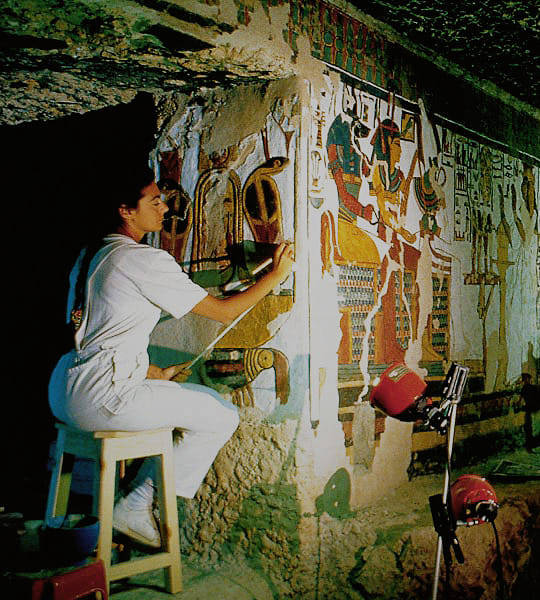
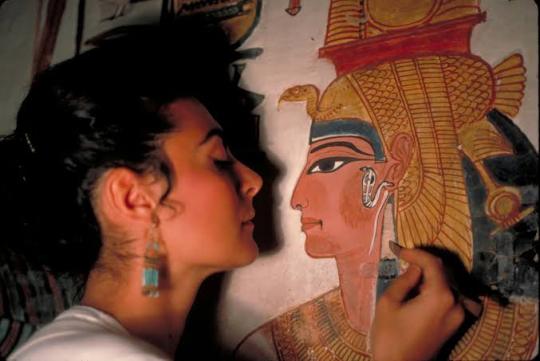

restauração da tumba da rainha nefertari
0 notes
Text

Relief of Osiris, green-skinned
Tomb of Nefertari (QV66), Valley of the Queens, West Thebes.
400 notes
·
View notes
Photo
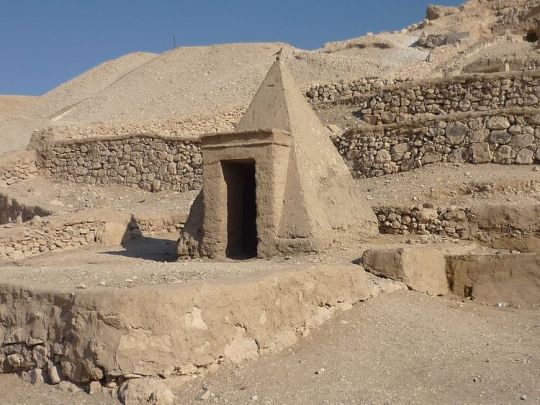
Deir el-Medina
Deir el-Medina is the modern Arabic name for the worker's village (now an archaeological site) which was home to the artisans and craftsmen of Thebes who built and decorated the royal tombs in the nearby Valley of the Kings and Valley of the Queens.
The ancient inhabitants called the village Pa Demi (“the village”) but it was referred to in official correspondence as Set-Ma'at (“The Place of Truth”) because the workers there were thought to be inspired by the gods in creating the eternal homes of the deceased kings and their families. Early in the Christian era the village, then deserted, was occupied by monks who took over the Temple of Hathor for use as a cloister. The temple was referred to as Deir el-Medina (“Monastery of the Town”) and this name finally came to be applied to the entire site.
Unlike most villages in ancient Egypt, which grew up organically from small settlements, Deir el-Medina was a planned community. It was founded by Amenhotep I (c.1541-1520 BCE) specifically to house workers on royal tombs because tomb desecration and robbery had become a serious concern by his time. It was decided that the royalty of Egypt would no longer advertise their final resting places with large monuments but, instead, would be buried in a less accessible area in tombs cut into the cliff walls. These areas would become the necropolises now known as the Valley of the Kings and the Valley of the Queens and those who lived in the village were known as “Servants in the Place of Truth” for their important role in creating eternal homes and also remaining discreet regarding tomb contents and location.
Deir el-Medina is among the most important archaeological sites in Egypt because of the wealth of information it provides on the daily life of the people who lived there. Serious excavation at the site was begun in 1905 CE by the Italian archaeologist Ernesto Schiaparelli and furthered by a number of others throughout the 20th century CE with some of the most extensive work done by French archaeologist Bernard Bruyere between 1922-1940 CE. At the same time Howard Carter was bringing the treasures of the royalty to light from Tutankhamun's tomb, Bruyere was uncovering the lives of the working people who would have created that final resting place.
History of the Village
The earliest extant ruins at the site are from the reign of Thutmose I (1520-1492 BCE), son and successor of Amenhotep I, but there is no doubt that it was Amenhotep I who first planned the site. He and his mother, Ahmose-Nefertari, were worshipped as protective gods at the site throughout its history. The workers also venerated the cobra goddess Meretseger (whose name means “She Who Loves Silence”), the personification of the Theban necropolis and protector of the dead and, especially, of their tombs.
By the time of the New Kingdom (c.1570-c.1069 BCE) tomb robbing had become almost epidemic in scope. Although measures such as false doors and labyrinths had been a part of tomb building since the Old Kingdom (c.2613-2181 BCE) they were not effective in keeping robbers from reaching the burial chamber and the vast treasures left there with the deceased. One gains an understanding of exactly how great the wealth in these tombs was when one considers the treasures of Tutankhamun's tomb discovered by Howard Carter in 1922 CE. Tutankhamun died before he was 20 years old and had not yet amassed the kind of wealth a king like Djoser (c.2670 BCE) or Khufu (2589-2566 BCE) would have had entombed for the afterlife.
The Valley of the Kings was selected as the new necropolis for royalty and the village was planned for easy access (a half hour's walk) from a worker's home to the tombs. The village was in continuous use from the time of Thutmose I until the collapse of the New Kingdom in c. 1069 BCE. Although the community and nearby necropolises were planned to safeguard the tombs of the kings, human greed and opportunity would eventually work to undermine the plan and some of the workers themselves would turn to robbing the tombs they had helped build and protect for an easy and quite substantial payoff. For most of its history, however, the village seems to have functioned as it was intended.
Continue reading...
148 notes
·
View notes
Text

Re in his ram-headed form, from the tomb of Queen Nefertari (QV66)
319 notes
·
View notes
Text
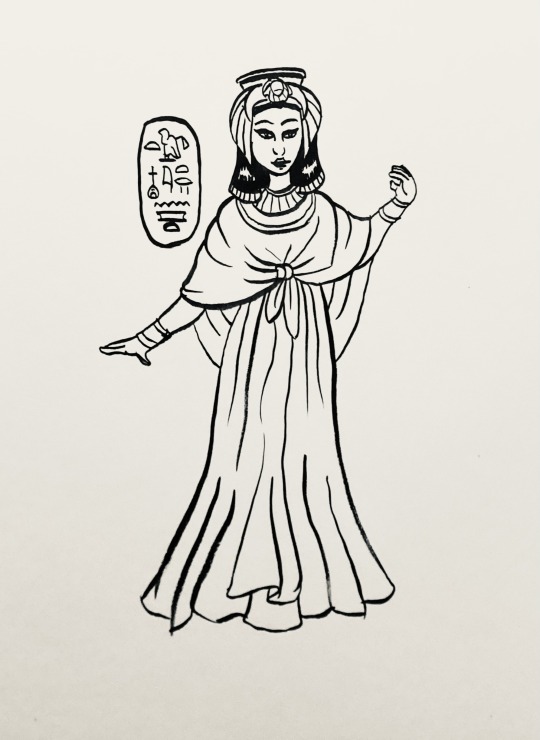
Day 18: Nefertari!
Nefertari, Great Royal Wife of Ramesses the Great, was queen of Egypt during a golden age for the empire. Her origins, however, are unknown - she wasn’t a close relative of Ramesses, but may have had ties to the royal family of the previous dynasty.
She was highly educated for a noblewoman, and her husband, who she married before his ascension to the throne, seems to have valued her political assistance and advice. In addition to her standard queenly titles, he dubbed her “the one for whom the sun shines,” and constructed an independent temple for her beside his own at Abu Simbel.
Nefertari conducted her own diplomatic correspondence; she’s known to have sent letters and gifts to another powerful queen consort, Puduhepa of the Hittites, encouraging her to support close ties with Egypt, and in one of her tomb portraits is shown wearing Greek earrings, potentially the result of another exchange.
Nefertari died approximately twenty-five years into Ramesses’ rule. He constructed a lavish tomb for her, one of the largest in the Valley of the Queens. Though the tomb was looted, and her mummy either lost or unidentified, many of the wall paintings, some of the most beautiful in Egypt, survive to the present day.
#nefertari#egyptian history#ancient egypt#history#awesome ladies of history#october 2023#my art#pen and ink
38 notes
·
View notes
Text

Tomb of queen Nefertari Meritenmut (1300-1256 BC, 19th dynasty) Great Royal Wife of Ramses II the Great.
Valley of the Kings #Egypt
262 notes
·
View notes
Text

Queen Nefertari being led by Isis - Met Museum Collection
Note: This is a modern copy of an original
Inventory Number: 30.4.142
Original Dating: New Kingdom, Ramesside, Dynasty 19, ca. 1279–1213 B.C.
Location Information: Original from Egypt, Upper Egypt, Thebes, Valley of the Queens (Biban el-Malikat), Tomb of Nefertari (QV 66)
Description:
Nefertari was the main wife of pharaoh Ramesses II and her tomb with its vivid wall paintings is one of the most beautiful tombs in Egypt. This watercolor copy depicts the queen (left) being led by the goddess Isis (right). Noteworthy is that Nefertari’s husband, Ramesses II, is absent in these scenes, indicating the queen's high status that allowed her to directly interact with the deities without him; such depictions would not be possible for non-royal individuals.
#Queen Nefertari being led by Isis#new kingdom#ramesside#dynasty 19#upper egypt#thebes#valley of the queens#tomb of nefertari#met museum#30.4.142#deities#deitiesw#aset#womens clothing#NKRWC
0 notes
Text

1A
Princess (The Liar Princess and the Blind Prince) VS Eruca (Radiant Historia)
Sapphia (High-Class Homos) VS Zara (Disney Princess Enchanted Journey)
Lucina (Fire Emblem Awakening) VS Beatrice (Rune Factory 5)
Ace (Love Nikki) VS Angela (Trials of Mana)
Princess Pride (Mega Man Battle Network) VS Katora Paige (Inazuma Eleven GO Galaxy)
Kaguya Houraisan (Touhou Project) VS Miranda Vanderbilt (Monster Prom)
Elodie (Long Live the Queen) VS Merurulince Rede Arls (Atelier Meruru)
Pecorine (Princess Connect) VS Parasoul (Skullgirls)
2A
Princess (Twisted: The Untold Story of a Royal Visier) VS Princess Minnie (Mickey, Donald, Goofy: The Three Musketeers)
Rapunzel (Tangled) VS Catania (Barbie Mariposa and the Fairy Princess)
Mermista (She-Ra and the Princesses of Power) VS Starfire/Koriand'r (DC Comics)
Coronabeth Tridentarius (The Locked Tomb) VS Princess Vespa (Spaceballs)
Melinoe (Hades II) VS Blaze the Cat (Sonic the Hedgehog)
Chibiusa Tsukino (Sailor Moon) VS Midna (The Legend of Zelda: Twilight Princess)
Eilonwy (The Black Cauldron) VS Allura (Voltron: Legendary Defender)
Nefertari Vivi (One Piece) VS Rue Kuroha/Princess Kraehe (Princess Tutu)
1B
Aurora (Sleeping Beauty) VS Star Butterfly (Star vs. the Forces of Evil)
Isla Kokoro (Barbie: Princess Charm School) VS Merida (Brave)
Ariel (The Little Mermaid) VS Clara (Barbie in the Nutcracker)
Princess Peach (Mario Games) VS Belle (Beauty and the Beast)
Snow White (Red Shoes and the Seven Dwarfs) VS Aurora Syalis Goodereste (Sleepy Princess in the Demon Castle)
Shirahoshi (One Piece) VS Princess Selenia (Arthur and the Invisibles)
Marianne (Strange Magic) VS Nunnally vi Britannia (Code Geass)
Ahiru/Princess Tutu (Princess Tutu) VS Poppy (Trolls)
2B
Kilala Reno (Kilala Princess) VS Griselda (Ys: Memories of Celceta)
Tsunami (Wings of Fire) VS Gruier Serenity (Mouretsu Pirates)
Priscilla Barielle (Re:Zero) VS Lucia Nanami (Mermaid Melody Pichi Pichi Pich)
Momo (Magical Princess Minky Momo) VS Princess/Hime-sama ('Tis Time For "Torture," Princess)
Princess Luna (My Little Pony: Friendship is Magic) VS Sofia (Sofia the First)
Stella (Winx Club) VS Haruka Haruno/Cure Flora (Go! Princess Precure)
Harumi (Ninjago) VS Princess Iron Fan (Lego Monkie Kid)
Mouscedes King (Monster High) VS Elena (Elena of Avalor)
9 notes
·
View notes
Text

Ptah
#Ptah#Egypt#Egyptian#ancient Egypt#ancient Egyptian#Kemet#Kemetic#egyptology#Kemeticism#Nefertari#tomb#valley of the queens#thebes#waset#Luxor
12 notes
·
View notes
Photo
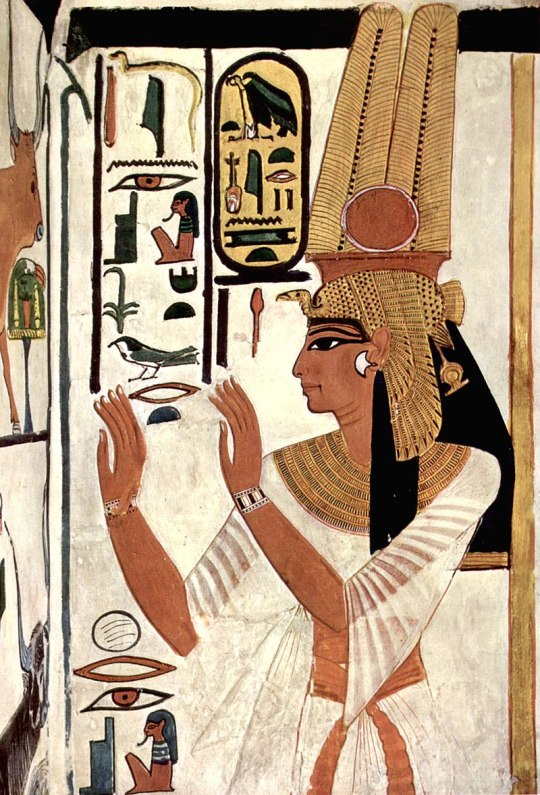
Tomb wall depicting Queen Nefertari, the great royal wife of Pharaoh Rameses II
#queen nefertari#nefertari#ancient egypt#tomb#wall#wife of pharaoh#Egypt's Pharaohs'#pharoah#rameses II#egypt#tomb wall
190 notes
·
View notes
Text
watching people reacting to Alabasta ark in the op anime and they raised a good point of “how did Chaka and Pell end up with the devil fruits of the alabasta guardian deities “ (cause judging by the statues etc in the tomb that is a tradition that didn’t start with them) so currently my brain is split between the devil fruits (being zoan types, which have already been said to have a will of their own) intentionally always re-spawning in alabasta (or making their way there) after the previous user dies… and the possibility of them actually containing a deity like nika (secretly mythical zoan fruits), which has the added benefit of kind of explaining how Pell survived All That (plus, who knows what tricks and secrets Nefertari (D) Lily had up her sleeves) or the last, horror inspired option, ritual cannibalism of some kind (which would seem extremely far fetched but on the other hand, that is the fanon consensus of how Big Mom got her powers so it’s not THAT impossible either)
#one piece#alabasta#one piece meta#one piece wano spoilers#in a lore sense#chaka one piece#pell one piece#pell the falcon#chaka the jackal#cannibalism#???#mythical zoan
9 notes
·
View notes